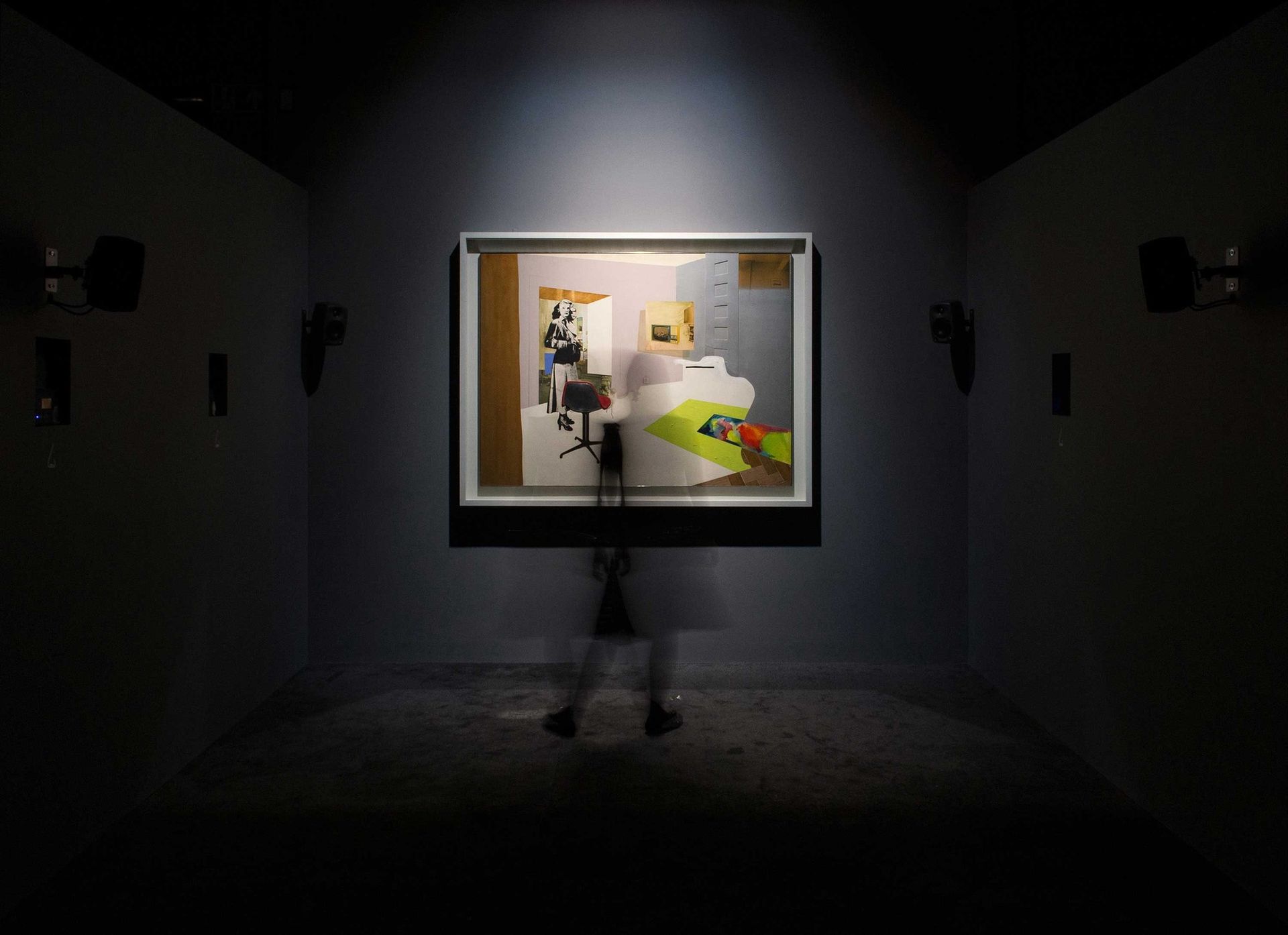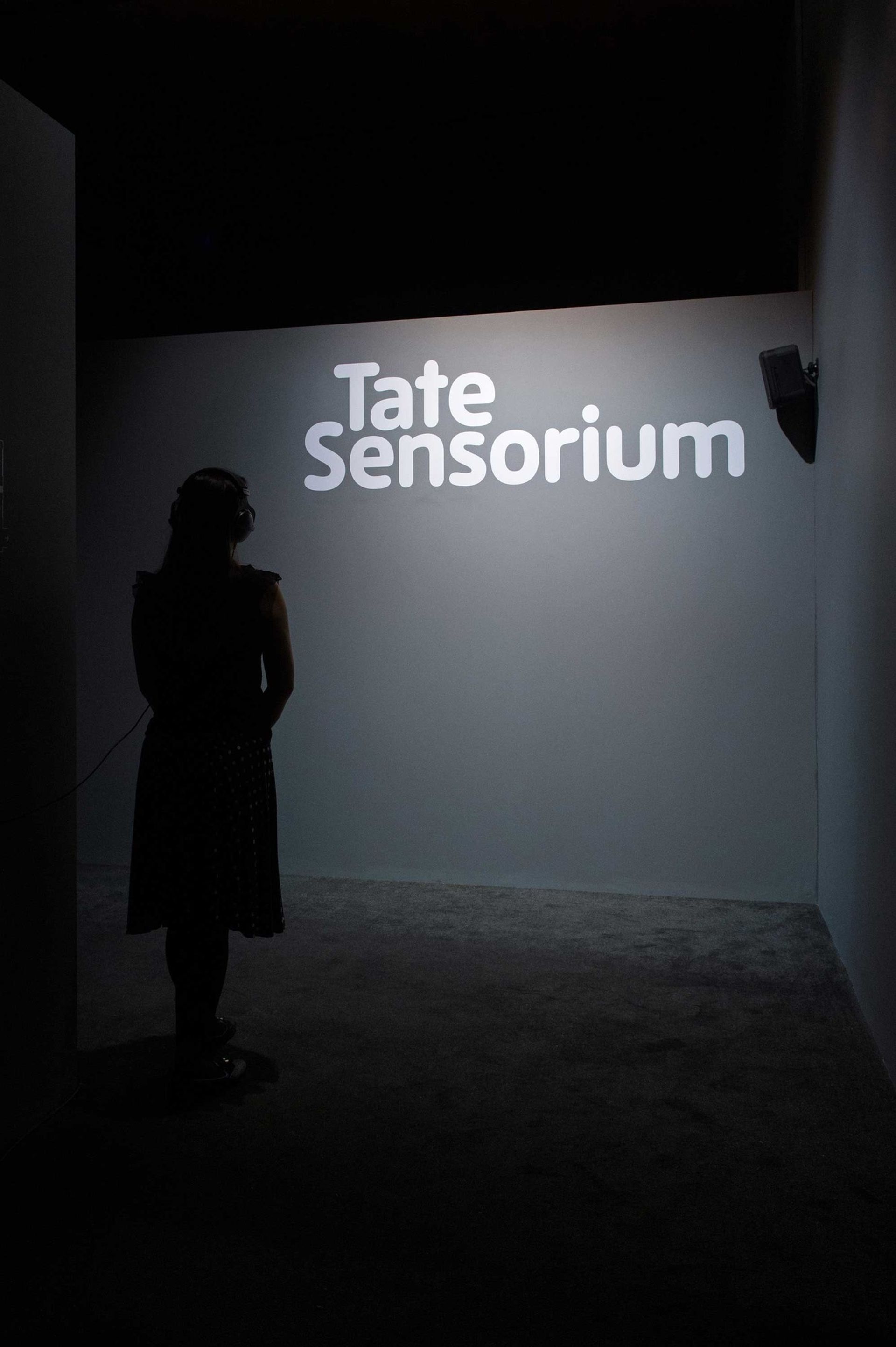The best way to see Tate Sensorium is to see it blind, so to speak. No prep, no reading-up on what to expect, or which works will be present. If you are planning on going, discard this review. You should not know that the barely-edible chocolate you will later eat is made of charcoal, sea salt, cacao nibs and smokey lapsang souchong tea. (It is apparently not dirt.) Nor, for that matter, should you know that the scent you will whiff while gazing at a Richard Hamilton painting is the original scent of Pledge cleaning product. No—go in blind.
The question of the exhibition—or more correctly, the event—is this: “Can taste, touch, smell and sound change the way we experience art?” The problem was devised by the Flying Object studio and is the winning project of the IK Prize 2015, an annual award for “an idea that uses innovative technology to enable the public to discover, explore and enjoy” Tate Britain’s collection in “new ways”. The principle of the show is relatively simple: four spot-lit paintings in four darkened sections of a gallery are presented with various devices that stimulate one or more of your senses. You must book a 15-20 minute slot and only four people can attend at a time.
On entering the gallery, you listen briefly to an introductory spiel from a disembodied female voice projecting through a loudspeaker (I later learn that the voice belongs to the British actress Tamsin Greig). You are given a device to wear on your wrist—a sort of basic Apple Watch but without the ability to tweet. The device measures your pulse and sweat during the experience, in order to ascertain which paintings and accompanying sensory stimuli you react to the most. (On completion of my visit, the data doesn’t download, so I do not get my results.)

Richard Hamilton, Interior II (1964)
From the start, the gallery is dark and the painting is lit in a theatrical manner. It is not bright enough for my liking but my eyes play a secondary role today. Richard Hamilton’s Interior II (1964) is flanked by two walls that dispense a floral scent—old-fashioned perfume, perhaps, or potpourri?—that are familiar but difficult to define. The sound of a television plays over the speakers and as we shuffle between the scent stations, the four of us try to keep our eyes on the painting. The domestic setting depicted in the work and homely smells do make you think momentarily about the objects in the painting. Is that a rug? Is the chair covered in fabric?
But for most of the four or five minutes I spend here, identifying the smells and sounds is what I struggle with. It makes me acutely aware of how reliant we are on vision to recognise and to categorise our other senses. Disembodied smells are very difficult to pinpoint. They seem to trigger responses in the most primitive area of the brain, so that certain smells transport us to an exact moment in time. But most of us do not have the cultured sense of smell of a perfumer, so this is a difficult game to play. “It is now time to move on to the next painting”, the recorded voice orders softly but firmly.
David Bomberg, In The Hold (around 1913-14)

At this point, the group of four is split in two. Standing in front of David Bomberg’s In The Hold (around 1913-14, see image at top of article), we are invited to “shake and smell” a set of angular containers that resemble stylish salt and pepper shakers. The sound they make is disappointing. They are muted by soft plastic, and are a far cry from the satisfaction of a maraca rattle. And the smell? No idea. Later I learn from the accompanying fact sheet that one smell is apparently “abstract: shrill, bringing out the blue colour [of the painting]”. Another scent is of “diesel and tobacco” in honour of the painting’s subject.
The soundtrack though, is a mix of angular, jagged, clashing noises. Can sound be angular? Or is it just the influence of the interconnected triangles and assorted polygons on Bomberg’s canvas? The auditory and visual compositions riff off each other. Abstract painting seems to work better than representational painting with sound. The literal paring of television murmurings with a television in the Hamilton gallery is too obvious.
This crossing over of the senses, a sort of forced synaesthesia, is not new in the history of painting. Around the time Bomberg’s work was created, Wassily Kandinsky—who was quite possibly a synesthete —produced paintings that, like (non-lyrical) music, were completely abstract. Bomberg’s abstraction is influenced by Cubism and apparently represents the hold of a ship, although at the time I see nothing of this. (Afterwards, despite learning of a ladder on the right hand side of the painting, I am still blind to the ship.) But again, there is little time to contemplate any of this. The voice coaxes us on.

John Latham, Full Stop (1961)
I don’t recognise the painting at first, as we take our place in front of a big black circle. We put on headphones and then take turns placing our hands into a box that blows bursts of air that occasionally synch with the sounds coming from the headphones. Percussive poundings and gong crashes are interspersed with imitation rain and explosive clatters that mimic the circular paint spatter of John Latham’s Full Stop (1961). The tactile element, which I later learn is not a burst of blown air but “focused ultrasound”, must be influenced by the method Latham used to create the painting: a spray gun. It reminds me of Latham’s series of One Second Paintings from the 1970s. With those works, Latham developed a theory of “Flat Time.” Rather than thinking of all that exists as objects in space, he proposed that everything was an “event” taking place in time. The One Second paintings became a manifestation of a “least event”, or the shortest possible action. A burst of the paint gun and done.
Latham seems an apt choice for such a show consisting of a series of events. You come, you experience, you leave. Your time is limited. But you feel rushed; you feel time as a constant watchman on your shoulder, voiced by a female actress with a kind but firm tone. “It is now time to move on…” she says once more. This four-minute event with Latham’s painting is over.

Francis Bacon, Figure in a Landscape (1945)
The final section has a spot-lit tray with four bite-sized chocolates in front of Figure in a Landscape (1945) by Francis Bacon. Eating in the gallery space is the only time I feel a little apprehensive during the whole experience. While smell, touch and hearing are often unnoticed by-products of looking at art, taste is a sense usually reserved for the ubiquitous gallery café—a reward for all that dutiful absorption of culture—or occasionally the canapé-fuelled vernissage. (Sometimes, of course, eating is the work itself, such as Rirkrit Tiravanija’s communal dining installations.)
Here it disrupts, and like visitors to Willy Wonka’s factory, we boldly toss the chocolate into our mouths. No one spits it out, and afterwards the gallery attendant praises us for being one of the few groups foolish enough to keep eating despite the foul taste. The ingredients are difficult to pin down. However much of a foodie you think you are, it is surprisingly hard to separate and identify flavours without visual prompts. I deduce chocolate from the chocolate colour and chocolate bonbon shape. Here, the visual aid helping you identify the other flavours is the painting and an accompanying soundtrack of heavy machinery. The painting becomes a prop to make sense of the otherness that we have been thrust into.
If you are not expecting great artistic revelations, then the entire experience is an amusing and unusual way of spending 20 minutes in a gallery. As an event, it is fun. But it probably won’t make you look at the paintings afresh, because you stop seeing even when your eyes are fixed on them. The voice at the beginning asks you to seek “your own interpretation”, and as you are whizzed through the dark gallery, with props and wafts to play to your senses, there is little time to no time to contemplate the works. Still, my sense of sight was piqued. The Tate Sensorium made me look at the collection in a new way by not allowing me to see it properly. The work was obscured by pageantry. I doubt this was the purpose of the exercise, but I want to return to Tate Britain and look—really look— at the paintings again. And then I’ll make a visit to the café to satisfy my other senses.
José da Silva is the researcher and digital producer at The Art Newspaper.
IK Prize 2015: Tate Sensorium, Tate Britain, London. Update: the exhibition has been extended until 4 October

